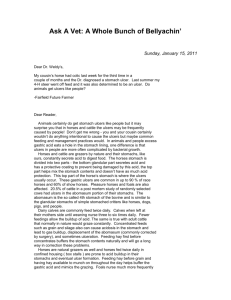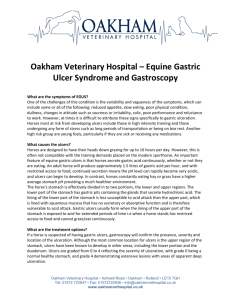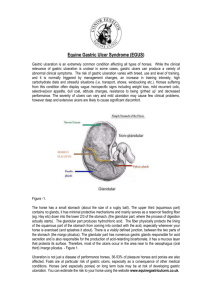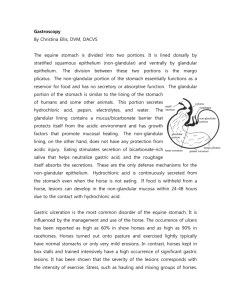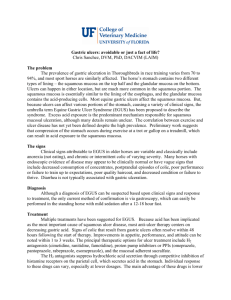Merial interim template
advertisement
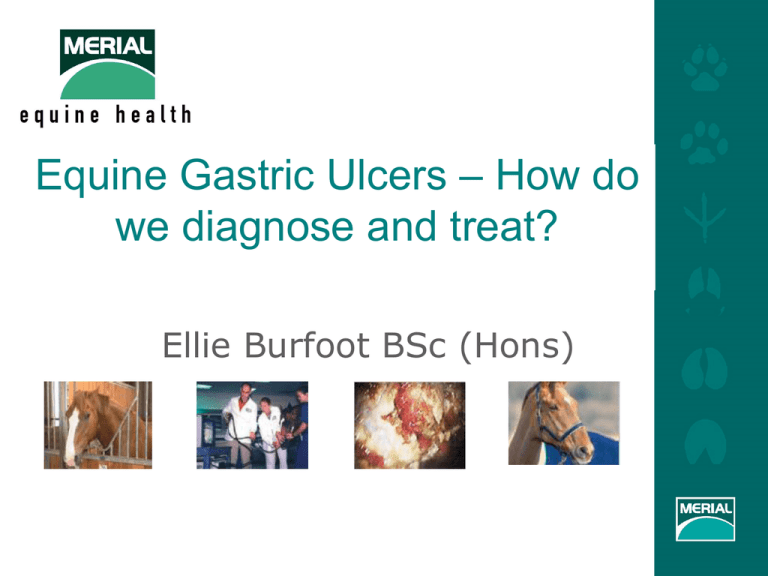
Equine Gastric Ulcers – How do we diagnose and treat? Ellie Burfoot BSc (Hons) Agenda • Introduction • Prevalence – How common is this disease? • Anatomy/physiology • Risk Factors • Treatment • Prevention Introduction Damage to the equine stomach lining due to excessive stomach acid or problems with the natural protection of the stomach lining • Serious health problem in foals and horses • Particularly prevalent in performance horses • Many risk factors • May or may not show clinical symptoms • May result in foal mortality Prevalence – How common is this disease? • 93% racehorses in training (Murray et. al 1996, 1989) • 60% other performance horses (McClure et al. 1999, Mitchell 2001) • More than 50% of foals have been shown to have EGUS (Murray 1997) • 37% in leisure/pleasure horses • Donkeys – 50%? How did nature intend the horse to live? Compartments of the Equine Stomach Cardia Squamous mucosa Duodenum Pylorus Margo plicatus Glandular mucosa Pagan, World Equine Vet Rev, 1997. Squamous Mucosa • Non Glandular • No sub mucosal glands. • No secretary or absorptive function. • No mucus and high susceptibility to peptic injury. • Most common location for gastric ulcers Squamous Mucosa Glandular Mucosa 2/3 of equine stomach. • Contains many secreting cell types: • Gastric G cells Gastrin. • Mast cells and Histamine. • Chief cells Pepsinogen Pepsin at pH <3.0. • Mucus neck cells Bicarbonate and hydrophobic mucus barrier. • Parietal cells Hydrochloric acid Glandular mucosa Inhibit acid secretion Stimulate acid secretion H2 Acetylcholine Gastrin Prostaglandins Parietal cell Acid Pump H+ Bicarbonate barrier H+ H+ Cl- H+ Cl- HCl H+ Stomach lumen Ulcer Grading • Range in severity – size and depth • Scoring techniques – assess severity and improvement through treatment • Severity and clinical signs don’t always correlate Grade 0 Lesion Intact epithelium May have reddening Freedom of Information (FOI) Summary for GASTROGARD Oral Paste for Equine Ulcers. Photo courtesy of MJ Murray. Grade 1 Lesion Small single or multiple lesions Freedom of Information (FOI) Summary for GASTROGARD Oral Paste for Equine Ulcers. Photo courtesy of MJ Murray. Grade 2 Lesion Large single or multiple lesions Freedom of Information (FOI) Summary for GASTROGARD Oral Paste for Equine Ulcers. Photo courtesy of MJ Murray. Grade 3 Lesion Extensive, often coalescing, ulcers with areas of deep ulceration. Freedom of Information (FOI) Summary for GASTROGARD Oral Paste for Equine Ulcers. Photo courtesy of MJ Murray. Risk Factors Intermittent feeding Diet Intensive Exercise Physical Stress Intermittent Feeding • Acidity in the equine stomach is greatest in absence of food • Feeding decreases acidity Acid secretion stimulated by food Food neutralises most of the acid Bicarbonate in saliva neutralises some acid • If denied food ulcers can develop within 24hrs • Horses continuously grazing therefore unlikely to develop ulcers Physiology of the Equine Stomach:Patterns of Acidity 8 Free Choice Timothy Hay 7 6 pH 5 4 3 2 1 0 6 12 0 Murray and Schusser, Equine Vet J, 1993. Time 18 2 Physiology of the Equine Stomach:Patterns of Acidity 7 Feed Deprivation 6 pH 5 4 3 2 1 0 6 12 0 Murray and Schusser, Equine Vet J, 1993. Time 18 24 Exercise (+walk) • High speed treadmill exercise abdominal pressure increases (Lorenzo-Figueras and Merritt, AJVR 2002) • High speed treadmill exercise pH decreases (Lorenzo-Figueras and Merritt, AJVR 2002) • Acidic contents forced into acid sensitive non glandular stomach region Exercise and Gastric pH Lorenzo-Figueras and Merritt, AJVR 2002 Physical Stress •Stall Confinement •Hospitalization, •Transportation, •Relocation Murray, Vet Med, 1991. Equine Gastric Ulcer Syndrome: Stall confinement Day 7 in stall • Horses on pasture: normal mucosa • 7 days stall confinement, free choice hay: squamous lesions Day 0 in stall Day 7 in stall Murray et al, Equine Vet J, 1996; Murray (personal communication), 1999. Clinical Signs in Adult Horses • Poor appetite. • Poor bodily condition. • Attitude changes. • Decrease in performance. • Mild to moderate colic. Murray, AAEP, 1997. Clinical Signs in Foals • Poor appetite or intermittent nursing. • Colic. • Poor body condition. • Frequently lies on back. • Bruxism (grinding of teeth). • Ptyalism (excessive salivation). • Diarrhea or history of diarrhea. Murray, AAEP, 1997. Diagnosis • Ulcers difficult to diagnose due to subtle, non-specific clinical signs • Endoscopy Only definitive method of diagnosis Can be difficult due to length of digestive tract Not all veterinary practices may have 3m endoscope required Treatment of Gastric Ulcers • Eliminate clinical signs • Promote healing of ulcer • Prevent recurrence Inhibit gastric acid secretion Treatment of Gastric Ulcers • Main traditional drug therapies Antacids Histamine H2 Receptor Antagonists Ulcer-coating agents (sucralfate) • • Not approved for use in horses No large-scale assessment of safety or effectiveness • No recommended dose or administration schedule • Variable results • Horses removed from training Omeprazole • Proton pump inhibitor binds to H+K+ - ATPase pump • Blocking pump shuts down the acid secretion allowing ulcers to heal • Only medication capable of blocking pump • Identifying pump stimulator not necessary. • First and only medication approved for use in and prevention of gastric ulcers in foals and horses • Do not have to remove horse from training. Most widely prescribed anti-ulcer therapy in humans (Losec) • Suppressor of gastric acid secretion • GastroGard® - Omeprazole paste - developed specifically for EGUS in horses The Acid Pump Stimulate acid secretion H2 Receptor Antagonists H2 Gastrin Acid pump Inhibitor Acetylcholine Prostaglandins Parietal cell Acid Pump GASTROGARD® H+ Bicarbonate barrier H+ H+ Cl- H+ H+ ClAntacids HCl Stomach lumen Ulceration does not just affect racehorses! Case study 1 • 8 yo Welsh section C • Jumping pony • At pasture for 4 hrs per day (overweight), good eater • No history of ulcers but really naughty in stable and under saddle • Better jumper in summer • Bad cribber & wind sucks • Recently lethargic, and had bout of colic • Scoping revealed squamous ulceration grade 2/3 localised to fundus, appearing to be along fold Case Study 2 • 6 year old advanced eventer currently off work at pasture as season over 2 months previous I.e on holiday • During season difficult to keep weight on and can be bucking bronco especially when show jumping • Ulceration in squamous region grade ¾ in glandular grade 4 Case Study 3 - 9yo Warm blood Dressage • Kept lying down, especially before a competition although never developed colic • Became lethargic and thin, poor coat • Grade 2 ulcers • 4 weeks GastroGard at 4mg/kg. • Clear after 4 weeks. • In an effort to cut costs switched to ranitidine. Signs reappeared almost immediately • Now on low dose GastroGard throughout the season • Increased frequency of feeds from 2 to 4 times daily and always has a full hay net Case Study 4: 14yr old KWPN Paralympic Team Dressage horse • Team dressage horse always done well, recently seen inconsistent performances especially if travelled • Pain on girthing up and bucking bronco for first few strides! • Routine scoping of Team GB horses revealed grade 3 squamous and glandular ulcers • Successfully treated for 2 weeks, and performance is more consistent and no bucking! Prevention of Gastric Ulcers ENVIRONMENTAL • Turn the horse out to pasture as much as possible Prevention of gastric Ulcers FEEDING PRACTICE • Regular feeding - the less time a horse has an empty stomach the better • Have hay available at all times while the horse is in the stall – 2/3 hay nets? • Alfalfa hay can help buffer stomach acid due to high calcium and protein content (Nadeau et al 2000) • Limit grain rations • Scatter feeding and apple bobbing! Prevention of Gastric Ulcers EXERCISE • Don’t train on an empty stomach • Consider exercise regime – increased risk of ulcer formation in horses under intense training schedules The Take Home Message! • Ulcers can affect any breed, age or discipline. • As horse owners you can prevent ulcers through good management. • Clinical signs are subtle and non specific. • Ulcers can be successfully treated with no long term affects. Gastroscopy Clinic at Priors Farm • Wednesday 6th June • 6-8 horses can be scoped. • If you feel your horse is a suitable candidate please speak to one of the Vets tonight or phone the practice. • Gastroscopy will be free on the day for those horses selected. Thank you!


